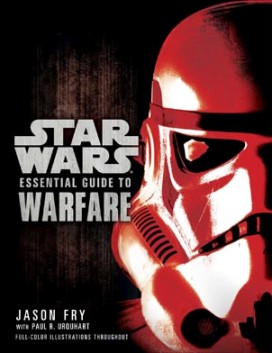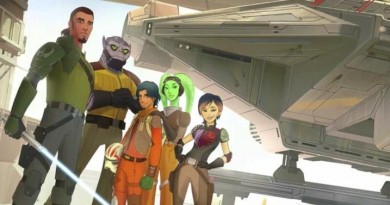The Art of Telling War Stories
 Cross-posted at Suvudu:
Cross-posted at Suvudu:
After much anticipation, many fans are excited for this week’s release of Star Wars: The Essential Guide to Warfare. I have to admit, when I first heard about this book it didn’t really pique my interest. That’s not to say I’m not intrigued by the war side of the franchise – some of my favorite scenes in the movies are the Battle of Naboo in The Phantom Menace and the opening battle over Coruscant in Revenge of the Sith. It’s just that, among all the millions of tidbits of information that create the galaxy far, far away in my mind’s eye, the minutiae of warfare don’t rank particularly high in my personal “need-to-know” category. To my delight, though, I discovered there’s a whole lot more to the book than details on the militaries, commanders, wars and battles of the millennia of Star Wars history.
By the time I got the book in my hands, fans had been treated to previews of some of the exceptional artwork. Teaser images from the Warfare guide were posted on the Star Wars Books Facebook page, io9.com, EUCantina, and FANgirl Blog to hint at what readers might expect. When I thumbed through the book itself, I was immediately struck by the beauty of the artwork and the layout. Little tidbits of prose grabbed my attention, too, as I continued my perusal. Author Jason Fry told me that he envisioned the book as “an exploration of war and how it had shaped the Star Wars galaxy, told from shifting points of view and using different techniques.” He definitely delivered. The combination of the art and prose really works, and the book is organized in a way that you can just sit down and read a section here or a chapter there and still really enjoy it.
Jason also described why he found the alternating in-universe POVs appealing as a means for presenting the narratives in the book:
I thought they would guard against what might otherwise have been a pretty grim or dry book, by letting me change up the tone and language. I also thought that tactic was a good way to freshen up material fans were very familiar with – Baron Fel’s biography is recounted by Wedge, a fellow pilot and Corellian, there’s an (in-universe) political bent to the accounts of Thrawn and Pellaeon, and so forth.
Jason picked some of my favorite parts to use as examples. The Fel biography was one of the first pieces of prose I stopped and read – when the fabulous artwork by Drew Baker of the Baron caught my attention. After finishing the biography I realized The Essential Guide to Warfare isn’t just meant to be an accounting of facts, but also an experience in glimpses of the stories of the men and women who fought in the wars. So if you like character studies and fleshed out backstories for organizations found in the movies and the Expanded Universe – have you ever wondered, for instance, about how the Trade Federation attained such influence in the galaxy that it could blockade Naboo? – then this book is going to be right up your alley.
Jason wasn’t only the book’s author, though – it’s apparent he also served as the field general who marshaled quite a bit of intel, interacted with his peers in various other service branches, and gave marching orders when necessary.
Leland Chee, Pablo Hidalgo, Tony Rowe, and others at Lucasfilm were really helpful in batting around ideas and getting down in the weeds with geeky stuff such as capital-ship classifications. And then there was crowd-sourcing – not just from fleet junkies on TheForce.Net, but also by reviewing talk pages on Wookieepedia. Talking about the book as a whole, the text is just part of a pretty gigantic collaboration. All props to Erich Schoeneweiss for that – his vision was critical as mine in shaping the book, plus he had a lot more balls, bowling pins and what-not to keep airborne. But I think Erich would say something similar about the big picture: If you don’t want to get lost, start with a good map.
Weaved in cleverly amid the character bios and narrative is quite a bit of useful, detailed information for all types of Star Wars fans. Whether you are trying to determine what insignia the Imperial officer you’re cosplaying should have, want to know more about TIE fighters or AT-AT walkers, need to find the full duty roster for Red Squadron, or are just curious what the color designations mean on the clones’ armor, it’s in this book. Pick up a copy, flip through the pages; between the art, the prose, and the cool trivia I’ll bet you can’t resist it. Then the next time a Star Wars marathon shows up on Spike TV, you’re definitely going to be able to impress your friends and loved ones with the things you learned between its covers.
- Hyperspace Theories: Bad Luck Ghorman - June 2, 2025
- Hyperspace Theories: One Year Later as ANDOR Kicks Off Season Two - May 15, 2025
- REVIEW: Tales of the Underworld - May 4, 2025











Ooh. I’m glad you wrote this. I originally thought maybe one day I’d pick it up and flip through it, but now I’m definitely more interested.
Thanks, Kay. That’s why I wrote it. I really enjoy picking the book up and reading parts. I like the movie and post-movie stuff the best.